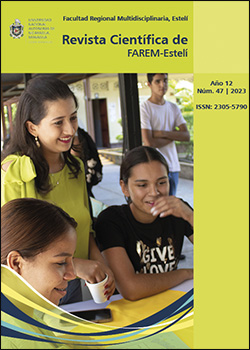Biological risks associated with working conditions in the personnel working in the BIOMEDIC clinical laboratory in the city of Granada, Nicaragua, January 2023
DOI:
https://doi.org/10.5377/farem.v12i47.16855Keywords:
Working conditions, risk factors, biological risks, biosafety, biological agentsAbstract
The purpose of this article is to identify the biological risks associated with working conditions in the personnel working in the BIOMEDIC clinical laboratory in the city of Granada, Nicaragua in the period January 2023. It is a descriptive-quantitative cross-sectional study, whose study area was the clinical laboratory BIOMEDIC Granada, Nicaragua. The universe and sample of this study consisted of 19 collaborators. The information was collected by means of a survey and observation. On the other hand, according to the data analysis, the predominant socio-labor characteristics were that the majority of the collaborators were female (68.4%), with an age range of 20-40 years (53%), most of them had higher education (78.9%), they had more than 11 years of experience in their job (26.3%), and bioanalysts were the most exposed to biological agents during 8 hours (52.6%). In general terms, the collaborators had a medium-high perception of the risks to which they were exposed, highlighting their knowledge of the working conditions that should be provided in the BIOMEDIC clinical laboratory, which means that they perceive that there is good risk management within the different work areas. Now, according to the data analysis, the biological risk agents present were: viruses, bacteria, fungi, toxins (68%); they were also provided with personal protective equipment (100%). The collaborators consider the temperature of the work area as “regular” 30 degrees Celsius - 37 degrees Celsius (82.4%), they also perceive the lighting in their work place as “good” (100%), they take all the necessary biosafety measures (100%) and they have not suffered any occupational accident due to biological risk (100%).
Downloads
References
Beltrón Macias, F. E. (2020). Riesgos Biológicos en Laboratorios Clínicos en la ciudad de Portoviejo mediante el método Biogaval. San Gregorio. https://dspace.ups.edu.ec/bitstream/123456789/23927/1/UPS-GT004113.pdf
Carrasco, M. J.-M. (DICIEMBRE de 2016). Repositorio UNAN. https://repositorio.unan.edu.ni/3748/1/61913.pdf
ISTAS. (2021). Enfermedades de riesgos biológicos. https://istas.net/salud-laboral/peligros-y-riesgos-laborales/riesgo-biologico
Ley general de higiene y seguridad del trabajo. (2007). ley general de higiene y seguridad del trabajo. Managua. http://legislacion.asamblea.gob.ni/Normaweb.nsf/($All)/16624DBD812ACC1B06257347006A6C8C?OpenDocument
OMS. (2005). OMS. Manual de bioseguridad https://www.who.int/topics/medical_waste/manual_bioseguridad_laboratorio.pdf
Rodríguez González, M. (2009). Riesgos biológicos en instituciones de salud. MEDWAVE. http://doi.org/10.5867/medwave.2009.07.4040
Torrez, L. V. (2014). Riesgos biológicos en el personal. León. https://onx.la/59ee2
Yoel Padrón Vega, S. d. (2017). Accidentes por riesgos biológicos. http://scielo.sld.cu/scielo.php?script=sci_arttext&pid=S1561-31942017000200008
Vázquez Macías AC, Ayala Rodríguez IM, Domenech Cañete IO, Martínez Motas IF, Rodríguez Camiño R. (2019) Riesgo biológico en los laboratorios de Microbiología de las instituciones de salud. Rev Panorama. Cuba y Salud [Internet]. 14(1):61-67.http://www.revpanorama.sld.cu/index.php/rpan/article/view/
Published
Issue
Section
License
Copyright (c) 2023 Revista Científica de FAREM-Esteli

This work is licensed under a Creative Commons Attribution-NonCommercial-ShareAlike 4.0 International License.



